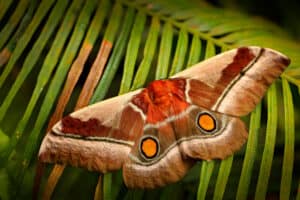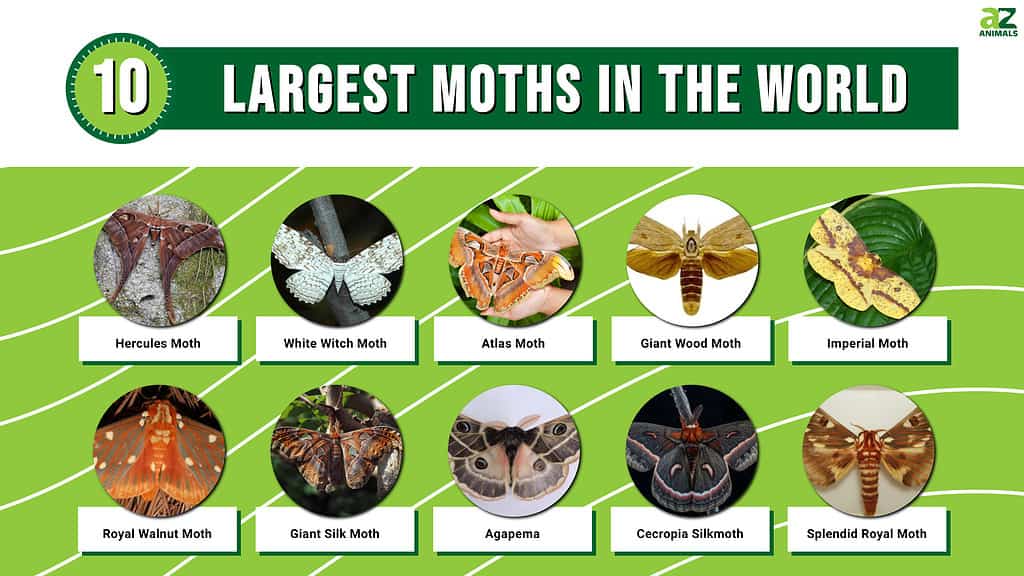
Numbering over 160,000 species worldwide, moths are some of nature’s most important pollinators. Moths and butterflies belong to the Lepidoptera insect order, and moths make up 89-94% of the species. There are a few easy distinctions you can look for to determine if you are looking at a moth or a butterfly.
The antennae are shaped differently with club-shaped antennae with a bulb on the ends. Moths have a feathery look with a jagged edge. Typically butterflies are more colorful, although many moths have beautiful colors. Moths shed scales that look like a powdery substance on your fingers if you touch them. It is natural for this shedding and does not affect the lifespan of the moth.
Moths generally fly at night, but some species do fly during the daytime. They also fold their wings differently. Butterflies fold them toward their backs, and moths fold them over their abdomen. The life cycle is similar, with one significant distinction in the transformation process. A moth caterpillar will build its cocoon out of a silk-like substance. The butterfly caterpillar builds a hard chrysalis.
An important insect to ecosystems, pollinating more than any other insect, moths also pose problems for agriculture. For this reason, farmers use pesticides and herbicides to kill the moths and protect their crops. Runoff from the crops is endangering surrounding ecosystems and threatening the Lepidoptera population. Below you’ll find 10 of the largest moths in the world as measured by their wingspan.
#10 Splendid Royal Moth (Citheroma Splendens)
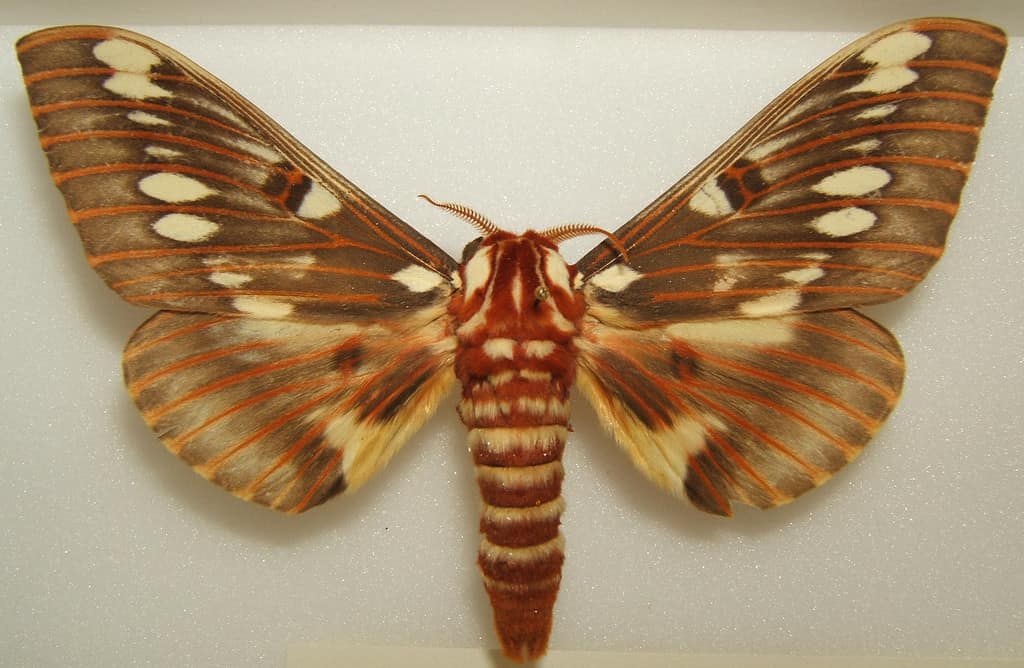
The Splendid Royal Moth is found along the north edge of Mexico and the lower parts of the United States.
©Shawn Hanrahan / CC BY-SA 2.5 – License
You can find this royal beauty along the north edge of Mexico and the lower parts of the United States. The mating season is a short July-August, having groups of 1-4 eggs at a time laid on a host leaf.
They are dark grey with red veins and white markings and prefer the tasty leaves of the wild cotton, manzanita, New Mexico evergreen sumac, and squawbush.
They will burrow in underground chambers in September for the pupa stage of the life cycle, re-emerging as a moth.
#9 Cecropia Silkmoth (Hyalophora Cecropia)
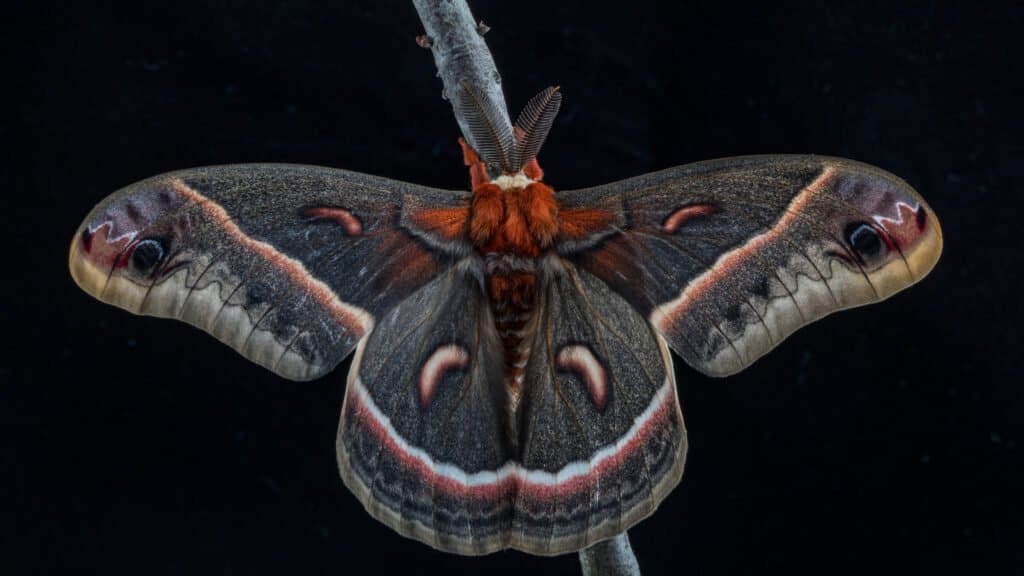
The
cecropia moth
‘s wingspan can reach nearly six inches!
©Jim and Lynne Weber/Shutterstock.com
A beautiful specimen adorned with red, white, and yellow wings, black “eye” markings, and a frosted appearance on the wings. The abdomen has bands of red and white. This moth has a wingspan of 5 ⅞ inches and an adult lifecycle of 2 weeks.
Found East of the Rocky Mountains, these moths prefer the forests in the United States and Canada. The bolas spider can mimic the pheromones of a female cecropia and will use the scent to draw male moths into their webs. The moths mate from March to July and, in specific areas, will mate from May to June, then repeat two weeks later.
#8 Agapema Oculea & Agapema Polyphemus
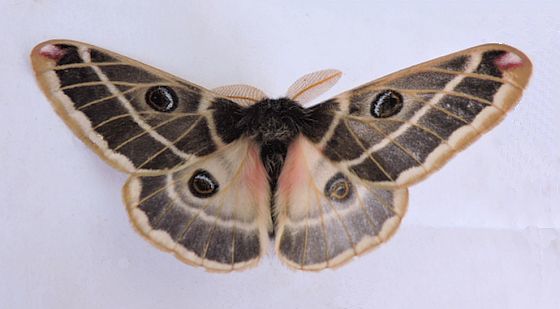
Agapema moths are a subgenus that falls under the genus Saturnia. This moth is an Agapema homogena, or Rocky Mountain Agapema.
©jimeckert49 / CC BY 4.0 – License
Reaching a wingspan of nearly 6 inches, the Agapema family has two very similar species. The Agapema oculea is tan with orange, blue, and black eyespots. There is a marginal black line, and there may be a yellow or red tint to the body. The Agapema polyphemus is reddish or yellowish-brown, while the underside has pink, brown, or rust markings.
The Agapema oculea has one mating in June-August and lives in oak woodlands and mixed forests of the Southwestern United States. The Agapema polyphemus mates once in the Northern United States from May to July, twice in the middle regions from April to May, and again in July to August, and several mating cycles throughout the Southern United States.
#7 Giant Silk Moths (Saturniids)

There are a number of giant silk moths with wingspans that can reach up to 6 inches!
©pr2is/Shutterstock.com
The giant silk moths include some species like polyphemus moth (Antheraea polyphemus), luna moth (Actias luna), Columbia silk moth (Hyalophora columbia), and cecropia moth (Hyalophora cecropia), which we’ve already detailed.
The color variations go from shades of brown, orange, and yellow forming “eye spots” in the polyphemus moth to bright green with pink/brown spots and tails on the hind wings in the luna moth, to dull, waxy green with rows of orange, yellow, or blue adorning the wings in the Columbia silk moth, to a brighter colored cecropia moth.
Each of these produces silk that is harvested and used in silk production in Asian and South American cultures. The colors vary from white silk to light brown, silvery brown, and brown, respectively.
These silk-producing moths have a wingspan of up to 6 inches and are native to deciduous rainforests and wooded areas. When it is mating time, the female moth will release pheromones for only 2-3 hours, attracting males from several miles away.
#6 Royal Walnut Moth (Citheroma Regalis)

The Royal Walnut Moth moth is native to the Southeast regions of the United States.
©Patrick Coin / CC BY-SA 2.5 – License
The Royal Walnut Moth reaches up to a 6 ¼ inch wingspan, and the larva has its own name, the hickory horned devil. This moth is native to the Southeast regions of the United States. An exciting coloring, the moth has grey-green wings with orange striping and a series of yellow dots. The body is orange with narrow yellow bands. This is a considerable change from the blue-green color of the moth in its caterpillar stage.
Mating only one generation per season, these moths prefer to lay their eggs on walnut, butternut, or hickory tree leaves. They will also use the leaves of persimmon, sweetgum, and sumacs. Some scientists believe that the larvae grow faster and larger on persimmon leaves.
#5 Imperial Moth (Eagles imperialis)
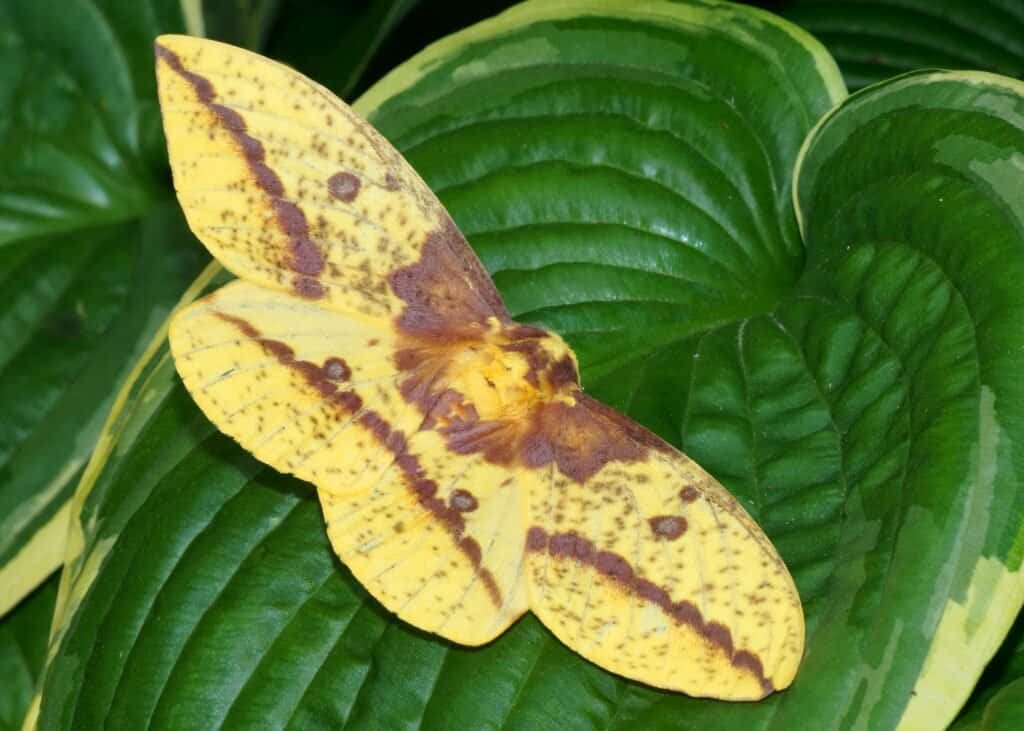
©Matt Jeppson/Shutterstock.com
The imperial moth or Eagles imperialis is primarily yellow with pink/purple-brownish patches and spots. Its wingspan can be as large as 6 ⅞ inches. The adults do not feed. They take flight after sunrise and will mate after midnight on the same 24-hour cycle. The females lay their eggs on a leaf, sometimes a single egg, or in groups of 2-5 eggs. It takes about two weeks for the eggs to hatch.
The imperial moth can be found around parts of the United States and Canada. One main difference between males and females in the Imperial Moth is the antennae. The male antenna is quadripectinate, then narrowed down to a more simple singular-looking antenna. The female does not have the quadripectinate but only has a singular-looking antenna.
Most Imperial Moths emerge in late summer. This timing helps with their natural defense against predators. Their colors allow them to blend in with falling leaves that often share similar colorings. The moth is commonly found on the forest floor with leaves. When you see these moths collected near lights, it will likely be the females who have already mated and laid their eggs.
#4 Giant Wood Moth (Endoxyla Cinera)

Giant wood moths are said to be the heaviest type of moths globally.
©Public Domain – License
It is very unusual to find one of these mammoth-sized moths. The wingspan is measured at 9.8 inches and is said to be the heaviest moth globally, weighing in at just over an ounce. These moths exist along the coast of Queensland and New South Wales. Attracted to the softwood of eucalyptus, the larval stage ranges from 1-3 years and has a purple and white banding. This coloring goes away as they mature.
The adult is grey and has a short life cycle, living only a few days before laying eggs and dying. The females do not eat and survive on reserves stored up while in the larva stage. The females do not fly well, so they are found resting on tree trunks or wooden objects like fence posts.
#3 Atlas Moth (Attacus Atlas)

A gigantic
atlas moth
has tips of the wings that resemble the heads of snakes, which would ward off enemies.
©Cocos.Bounty/Shutterstock.com
If you are in Southeast Asia, you might run across an Atlas Moth. An intimidating wingspan of 10-12 inches brings this moth near the top of our list. The intricate colors and patterns on the wings include reddish-brown with white, black, pink, and purple designs. The underside is paler in color.
It is thought that these moths have a defense against predators’ strategy built into their colorful pattern. The tips of the wings resemble the heads of snakes, which would ward off enemies. During the caterpillar stage, they will spray secretions much like skunks when predators are nearby.
#2 White Witch (Thysania Agrippina)
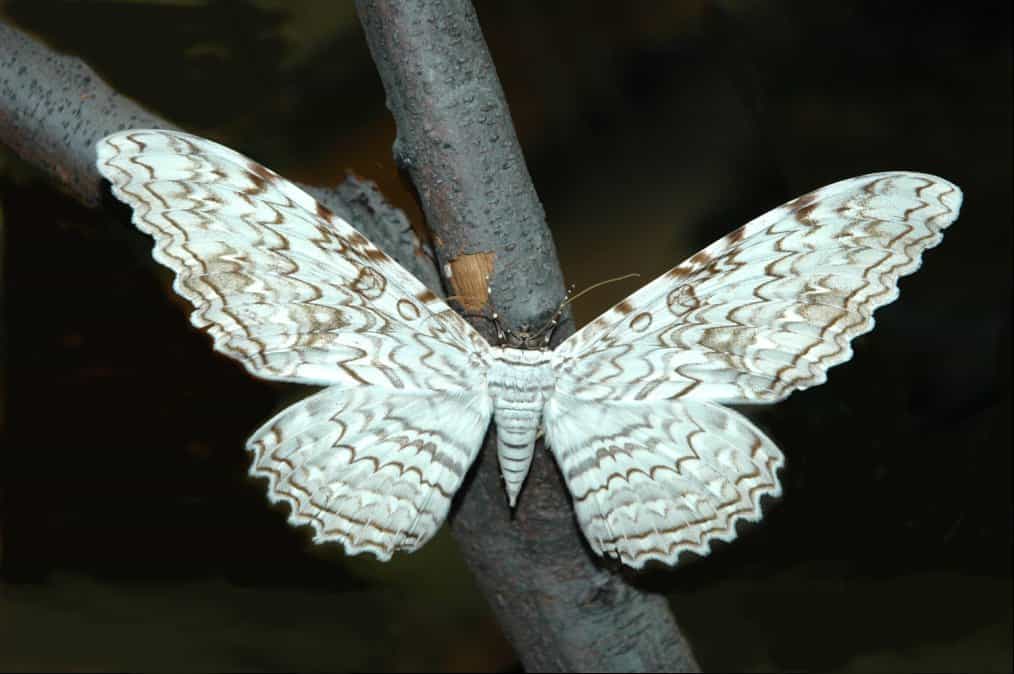
The beautiful white witch moth is also called the Birdwing Moth, Ghost Moth, Great Owlet Moth, and Great Grey Witch Moth.
©Acrocynus / CC BY-SA 3.0 – License
Native to South America, Mexico, and Texas, the White Witch has a wingspan of 11.4 inches. A rare sight, primarily due to its ability to blend in with trees, the White Witch has a zigzag pattern with shades of brown, black, or grey. This beautiful moth is also called the Birdwing Moth, Ghost Moth, Great Owlet Moth, and Great Grey Witch Moth. The life of a White Witch is 1-2 weeks.
#1 Largest Moth: Hercules Moth (Coscinocera Hercules)

Female
Hercules moths’ wingspans
can reach up to 14 inches
©ChameleonsEye/Shutterstock.com
This impressive species has a wingspan of 10.6 inches, with females growing up to 14.2 inches. That wingspan of over 14 inches makes Hercules moths the largest moth species in the world! They are located in North Queensland and New Guinea. The life span is a short 2-8 days since they do not have usable mouths to feed. They live long enough to mate and lay eggs.
In the caterpillar stage, the Hercules Moth grows up to 5 inches long and has fake eyes at the rear end to confuse its predators. Despite the short lifespan of this moth, they can live up to 2 years in the cocoon stage.
Moths That Are Large but Didn’t Make the List

Hawk moths are sometimes referred to as Sphinx moths.
©Sassafras56/Shutterstock.com
While they may not be as large as the specimens on our list, these moths are still considered quite large and are also rather beautiful. The following three moths all have impressive sizes – the Io moth (Automeris io) and the hawk moth (Eumorpha typhon), which are both found in North America and the Luna moth (Actias luna) can be found in Europe and Africa.
- Io moth (Automeris io) – has a wingspan of 2 to 3 inches; sometimes called the peacock moth.
- Hawk moth (Eumorpha typhon) – has a wingspan of 2 to 8 inches; sometimes referred to as Sphinx moths
- Luna moth (Actias luna) – has a wingspan of 3 to 4 inches; also known as the American moon moth
Summary of the 10 Largest Moths in the World
| Moth | Wingspan | |
|---|---|---|
| 1 | Hercules Moth | 14.2 inches |
| 2 | White Witch Moth | 11.4 inches |
| 3 | Atlas Moth | 12 inches |
| 4 | Giant Wood Moth | 9.8 inches |
| 5 | Imperial Moth | 6 ⅞ inches |
| 6 | Royal Walnut Moth | 6 ¼ inch |
| 7 | Giant Silk Moth | 6 inches |
| 8 | Agapema Oculea & Polyphemus | Nearly 6 inches |
| 9 | Cecropia Silkmoth | 5 ⅞ inches |
| 10 | Splendid Royal Moth | 5 ⅞ inches |
The photo featured at the top of this post is © Cocos.Bounty/Shutterstock.com
Thank you for reading! Have some feedback for us? Contact the AZ Animals editorial team.




